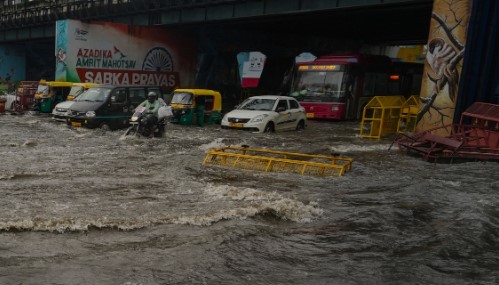Torrential rain has wreaked havoc in Delhi-NCR, submerging vast areas and causing severe traffic disruptions. Beginning yesterday, the downpour resulted in extensive waterlogging, marking a record-breaking event for the region.
The Meteorological Department reported that Delhi received 228 mm of rainfall from 8:30 am yesterday to 8:30 am today. This is the highest 24-hour rainfall in June since 1936, when 235.5 mm was recorded. Typically, Delhi sees an average of 80.6 mm of rain in June.
The deluge has disrupted daily life, with commuters facing significant waterlogging and traffic jams during the morning rush hour. Despite the chaos, the rainfall brought relief from the oppressive heat of the past two months, with today’s minimum temperature recorded at 24.7 degrees Celsius, 3.2 degrees below normal.
The unprecedented rainfall has highlighted severe shortcomings in Delhi’s infrastructure. Despite assurances from Delhi Mayor Shelly Oberoi on June 18 that the city was prepared for the monsoon, the first significant rain has already caused extensive waterlogging. Oberoi had previously stated that storm drains were clean and ready, promising a smooth monsoon season for residents.
Major intersections like ITO experienced water accumulation of about two to three feet, leading to massive traffic jams. The Hanuman Temple Intersection leading to Mandi House was submerged under three feet of water, resulting in road closures and disruptions on Ashoka Road, Feroz Shah Road, and Connaught Place. Similar conditions were reported at Moolchand and other parts of Delhi.
Noida faced equally dire circumstances. Despite inspections by the CEO of Noida Authority and officials on Thursday, severe waterlogging occurred in several areas, including the Mahamaya Flyover, Sector 62, and Sectors 15 and 16.
The record-breaking rainfall and its aftermath underscore the urgent need for improved infrastructure to handle such extreme weather events in the future.

















